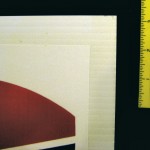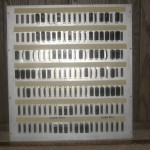I’m stuck trying to decide how best to mount the sign and how to protect it. I’ve gone back and forth a bunch of times. Ugh.
The critical (and interrelated) issues:
- How to protect the “paper” panels to keep the vulnerable top edges from peeling
- How to mount without having the mounting fail or allow water damage
Protecting the top edges
The original plan was to apply some clear overcoat to protect the edges (especially the top edges) of the paper panels and to provide some UV protection so the printer inks wouldn’t fade so quickly. Ideal would be to put a sheet of polycarbonate or something over it, but that’s expensive and makes the sign more complex.
There is adhesive overspray on the plastic around the panels, and I’m afraid that will keep the spray overcoat from adhering well – particularly at the vulnerable very top edge of the panels, which is what really needs mechanical protection.
It feels like there should be something lapped over the top edges of the panels. That would both keep water from trying to get under that top edge and provide at least a little mechanical support holding the top edges in. One possible way to do that would be to have the panels come to the very top of the plastic, and slip an upside-down U shaped channel (maybe 0.5″ high?) over the top edge. Much like the slip-on spines of clear plastic report covers, if anybody knows what those were. Of course it would have to be the full width of the sign for no leaks, and I don’t have any candidate materials to make it from. (Are there cheap plastic poster holders that would work? The corrugated plastic is 4mm thick, so something that would just hold a sheet of paper wouldn’t be a good fit.)
The problem with that is that then the mounting holes would have to penetrate the panels themselves. It just seems like water would manage to get in no matter how you treated the holes.
Yet another approach is to cover the whole sign with a piece of thick vinyl shower curtain (which I have). If that were folded over the top, it would protect very well from water, as well as kind of holding down any edges that started to peel. But then how do you hang it without piercing the vinyl? A metal backing plate would work… But how do you seal the edges and bottom? And would the vinyl yellow too badly in the sun, or just not stand up to the temperature extremes?
Hmm – what about a strip of the same waterproof paper maybe 3″ wide and as long as the width of the sign (OK, it would have to be pieced from the 11″ sheets I have). It would be folded over the top of the sign, lapping over the top edges of the printed panels (on both sides). That strip would be glued down just like the panels. Worst case, even if its bottom edge came loose, it would still provide significant water protection to the top edges of the panels because it lapped over them. Mounting holes would penetrate that strip, and might leak, but that small leakage (if any) would be the same as rain sheeting down over the top edges of the panels, but many orders of magnitude less.
Mounting
I left space above the panels for mounting holes that wouldn’t penetrate the panels, avoiding a possible source of water leaks. I planned to slide a heavy wire/thin rod through the second-to-top flute of the corrugated plastic and drill holes for mounting right below that. That all happens above the top edge of the panels. The rod would dramatically spread out the load the hangers would place on the holes in the plastic. I suspect that would be sufficient for mounting the quite light sign.
Another mounting idea is to back the whole sign with an aluminum plate. I found an old 24″x26″ RS-232 patch panel made of 1/8″ aluminum that would work. There’s obviously some disassembly, cutting, etc, but that’s not a show stopper. The plate would extend above the sign by an inch or so, allowing mounting holes that don’t compromise the sign in any way.
I think something like “Liquid Nails” exterior construction adhesive would work to stick the aluminum to the back of the sign. The original plan had been to have lettering on the back of the sign as well as the front. The aluminum back interferes with that, though a second piece of plastic with the back side lettering could be glued to the metal plate as well. But we’re adding more and more complexity.
- Corner detail and scale
Dithering
Part of the intent of the sign was an experiment in minimalist sign-making. The back plate would make a much more robust sign – which is a good thing – but diverges from the intent. If I chicken out and put lots of protection on the sign, we get a sign with longer life for the space – which is great. But I lose the information about how the minimalist design works. Would it hold up for a day? A week? A year?
So my head races in circles from original minimalist to heavy duty aluminum plate with two vinyl covered printed surfaces to the simple, effective protection of a U channel over the top – but then what about water leaks at the mounting holes? I’m sure you know the phemomenon.
Suggestions are welcome!



I thought you had mentioned using brass grommets for mounting in an earlier post. What do you think about that? If you went with the U-channel idea, maybe you could make it tall enough that the part without the U could have the holes in it for mounting. I don’t know if that makes sense.
As for protecting it, isn’t there a shellac or polyurethane spray that would work on the special paper you used?
Thanks for your comments and sounding board.
Brass grommets sound fine. I just don’t know if what I can get easily is brass rather than plated steel.
Your idea of a tall channel with mounting holes through the “tall” part above the top of the corrugated plastic is great – provides the “lapping” protection and mounting holes don’t penetrate the panels. But how does the channel attach with enough mechanical strength to hold up the sign?
Polyurethane is sounding like a good idea. There’s probably even stuff with UV protection.
Folding a strip of the waterproof paper over the top sounded good until I tried it. The paper – which is a lot more like thin white plastic sheet – doesn’t fold! That characteristic would be great for robust/indestructible pages of waterproof instructions or maps, but it doesn’t help here. I haven’t tried heating it – that might help.
Further feeding the indecision bog, there’s also clear “contact paper” – which I even have a roll of. It’s only 18″ wide, but even 2 pieces with a center overlap wouldn’t be out of the question. For some minimalist signage uses, it might be perfect. (Custom garage sale signs come to mind.) Here, the question of how well the adhesive would hold up outdoors raises its ugly head. Maybe I need – at home or at W88? – a “sign test bed” where some kind of signs could be left out for months to see how they behaved.
Even further feeding the indecision quagmire, I have some thin aluminum restaurant serving/shipping tray tops from lunches catered in to my office. It’s much heavier than aluminum foil, but you can bend it in your hands. Making a U-channel of that, long enough to cover the current extra material above the panels, providing an overlap for water protection and a little mechanical help to prevent peeling, while allowing mounting holes to remain above the panels might work. That stuff *does* bend easily. But it’s nice and shiny, and I’m afraid by the time it was handled and straightened out that very visible 1.5″ top frame would look bad. I must be catching the excessive worry bug from my wife. But I guess engineers are supposed to worry about stuff before they find out it doesn’t work. Dither, dither, dither…
How thick is the sign part? I thought the printed sheet had been adhered to a stiff backing. If so then can it be wedged into the U-channel (if the width of the channel was just a little too small) so that the pinching of the channel plus some adhesive would be sufficient to hold support the sign in the holder?
Ah – *plus some adhesive*. That would probably work, though I’m some reluctant to count on (two) fairly thin bands of adhesive while the sign is hanging on for dear life in some very high wind case.
I’ve come to a decision: I’ll use the aluminum foil as a top “flashing”. It’s easy to work with, and with some adhesive (Gorilla glue?) should stay put, as it’s not really under any stress. I’ll string a thin rod through and poke holes right below that for mounting. Those holes will penetrate the foil, but leakage there isn’t likely to do any damage.
Time to go down and glue on the back panels. Progressing again!